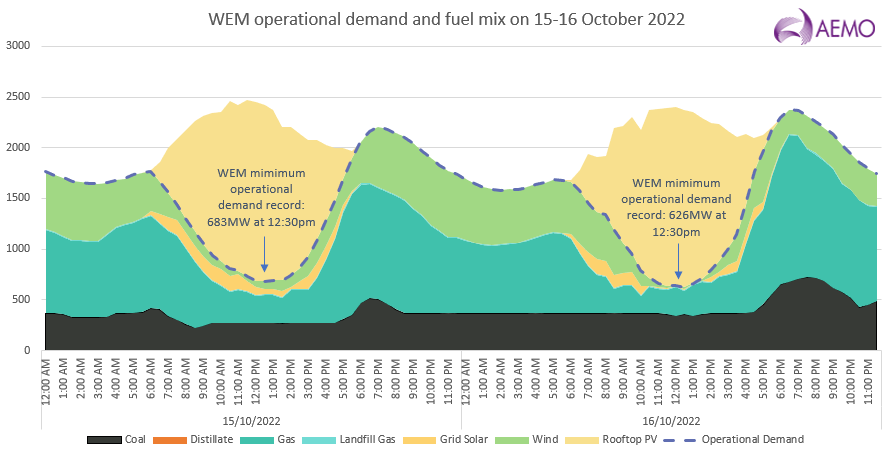When you join Plico, you become part of Plico’s Virtual Power Plant (VPP) - the first privately funded VPP in WA. With cutting-edge technology, the VPP enables West Australians to be part of the clean energy solution - helping to stabilise the grid and prevent blackouts, while enjoying the financial rewards.
The Plico VPP works to stabilise the grid by balancing supply and demand, and ultimately helps to prevent blackouts. In this article we’re exploring one scenario where the VPP can help – when energy supply to the grid is high and demand is low, or what is called minimum demand.
What is a VPP?
A virtual power plant is a decentralised energy supply composed of many individual power sources. These power sources are typically renewable energy generators, with residential solar systems being the most prevalent. A virtual power plant can distribute energy to the electricity grid to prevent demand from overtaking supply, an issue that leads to blackouts. It can also curtail the energy supply from these individual power sources to ensure that energy supply on the grid does not exceed the demand.
As part of a VPP, the central operator can draw on the energy generated by your solar panels and stored in your battery if required, and you may be compensated as a result (depending on the operator). This model makes renewable energy more reliable for everyone, by providing a stable alternative to power plants powered by fossil fuels and helping the transition to a clean energy future.
In early 2023, the Plico VPP was called upon twice to provide extra capacity to WA’s energy supply. Plico members received payments for having their batteries available to support the grid and for the energy they exported during the VPP activations.
What is minimum demand?
Perhaps the most common scenario for a VPP to be called upon is when demand for energy from the grid is higher than supply (as in the above events, or what is called peak demand). For example, during summer when temperatures are still high during the evening, many households run appliances to keep things cool, in addition to cooking, lighting and entertainment. This can lead to higher demand than supply, destabilisation of the grid and, ultimately, blackouts.
The opposite can also be true - when there is low demand for energy from the grid (i.e., minimum demand) but energy supply to the grid is high, and this can also result in blackouts.
In recent years, new records have been set for what is called minimum operational demand on the South West Interconnected Supply (SWIS), WA’s main grid network. The decrease in minimum operational demand has been largely driven by the rapid uptake of rooftop solar panels. The existing energy infrastructure wasn’t designed or constructed with renewable energy in mind, thus some challenges are to be expected, and responsibly managed.
 AEMO: WEM operational demand and fuel mix on 15-16 October 2022
AEMO: WEM operational demand and fuel mix on 15-16 October 2022
How does solar impact the grid?
When homes are not using all the solar energy generated from rooftop solar panels, the excess is exported to the grid. If that excess solar energy isn’t being used up because demand for energy is low, it creates an oversupply that destabilises the grid. The rapid uptake of solar panels in recent years has been beneficial to getting more clean energy in our energy supply, however it has been challenging for the grid to adapt.
Mild sunny days create the perfect conditions for minimum demand. Solar exports are high and household demand is low, as homes are not using their A/Cs for heating or cooling. When solar generation reduces in the evening, energy demand on the grid increases. These fluctuations pose a significant challenge.
With this challenge comes a unique opportunity. Household solar – specifically, VPPs – can be deployed to mitigate minimum demand.
Unlike coal generators, energy sources like wind, grid solar and gas can be switched off relatively easily to reduce supply to the grid and switched back on later in the day to increase supply. Coal grid generators on the other hand, take up to 48 hours to ramp up.
Coal therefore cannot be managed in the same way to meet fluctuations in energy demand. When supply outstrips demand, these grid generators cannot provide essential grid services like frequency control and voltage management. This destabilises the grid and can force the Australian Energy Market Operator (AEMO) to impose blackouts to protect the grid and its users.
The transition to clean energy isn’t going to happen overnight but it’s clear that VPPs have a vital role to play in ensuring a smooth and equitable transition.
How can Plico’s VPP help manage minimum demand?
Supporting the grid to manage minimum demand is a unique opportunity for the Plico community to demonstrate the power and flexibility of our VPP to provide real grid solutions and financial benefits to our members, and in doing so prevent blackouts for everyone.
While unmanaged solar can create challenges for the grid, it’s important to identify and introduce sustainable methods for managing the transition to renewable energy from fossil fuels. Without some form of control, whether that be mandatory (Emergency Solar Management, outlined below) or part of a VPP, these challenges will be more prevalent and lead to serious consequences for the grid and its users.
The challenges posed by a declining minimum operational demand, which is in part driven by the rapid uptake of rooftop solar panels, led the WA Government to introduce Emergency Solar Management requirements in 2022.
This means that all new and upgraded solar PV installations with an inverter capacity of 5 kW or less must have the capability to be remotely turned down or switched off in emergency situations.
Our VPP can help avoid mandatory control of solar systems by reducing supply and increasing demand through our fleet of Plico solar + battery and battery systems. The best part is that Plico members would benefit financially because they are part of the VPP.
By demonstrating that solar can be efficiently managed when supply exceeds demand on the grid, clean energy becomes a reality for the future of energy infrastructure. Not only this, but blackouts will be prevented, saving frustration and inconvenience for homes and businesses. It’s a win-win.
Plico has been testing the functionality of its fleet of solar + battery and battery only systems to provide minimum demand services to the grid. This ensures we are ready to respond and provide these services if and when they are needed. Importantly, we will only activate our VPP if it’s financially beneficial for our members.
Plico is at the cutting edge of renewable energy technology and providing real solutions to West Australians. Virtual Power Plants (VPPs) make solar part of the grid solution by stabilising the grid and preventing blackouts for everyone.
In addition to being part of Plico’s VPP, our unique offering includes solar + battery, 10 years of ongoing support and no big upfront cost - all for a low weekly fee. If you’d like to learn more about finding the system that is right for you, talk to one of our switched-on team by calling 1300 175 426.
Have a question about solar + battery?


